Special Report
Best Quarterback in Each Team's History

Published:
Last Updated:

The quarterback is the most important position in football, as indispensable in his sport as a goaltender is in hockey or a pitcher is in baseball.
The quarterback is the on-field leader of the offense who holds the fate of his team in his hands. In the National Football League, the quarterback is in many cases the face of a franchise. If he succeeds with one team over an extended period of time, he becomes linked with the city he plays for.
As the countdown begins for Super Bowl LII, 24/7 Wall St. has compiled a list of the best quarterbacks to ever play for all 32 franchises. We used data from a variety of sources, including Football Database and Pro Football Reference to arrive at our list.
Click here to see best quarterback for each NFL franchise.
Click here to see our detailed findings and methodology.
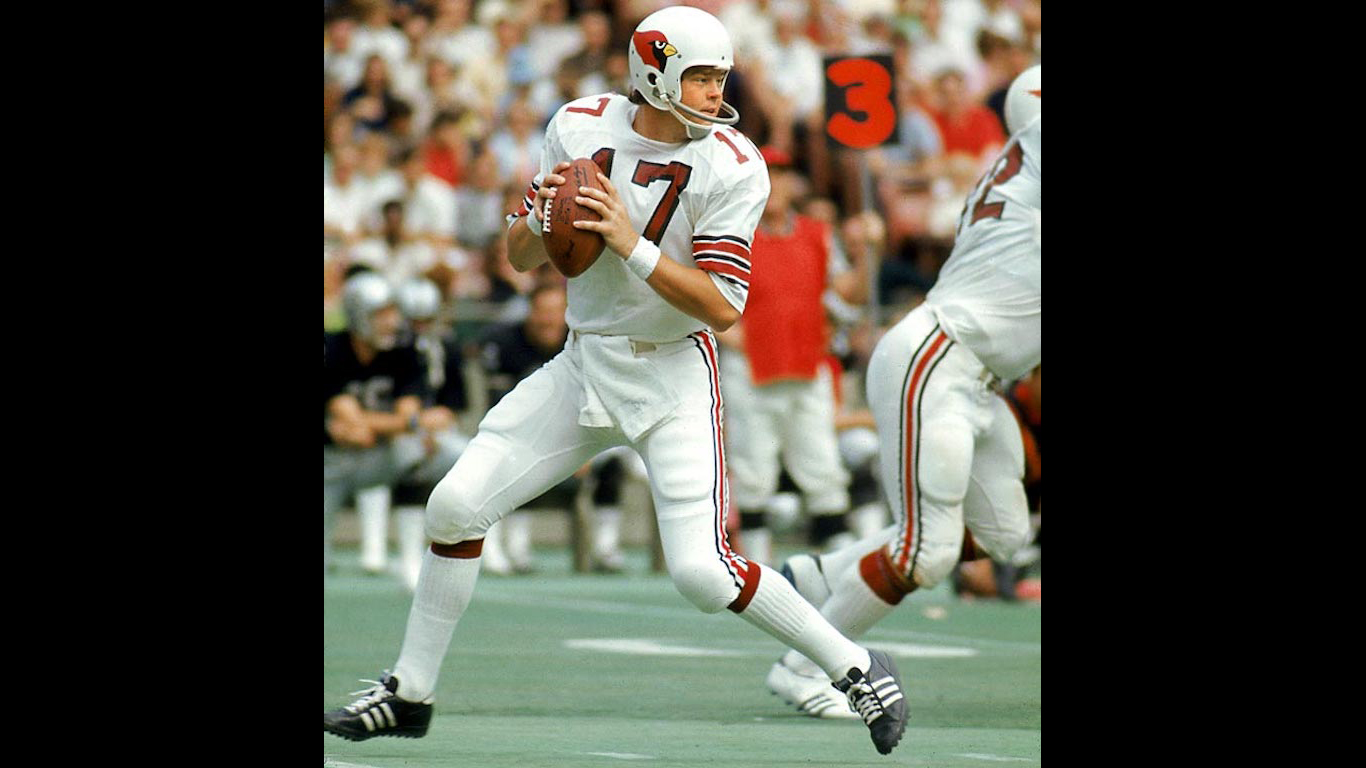
1. Arizona Cardinals: Jim Hart
> Years with Cardinals: 1966-1983
> Stats with Cardinals: 34,639 pass yds./209 TDs
> Record with team: 87-88-5
> Achievements with team: 4x Pro-Bowl
> Runner up: Kurt Warner
Jim Hart played for the Cardinals when the itinerant franchise was in St. Louis. He played more seasons with the team than any other player in the franchise’s history. His longevity with the Cardinals is a big reason he gets the nod for best franchise quarterback over Kurt Warner, who took them to their lone Super Bowl appearance.
Under pass-happy head coach Don Coryell, Hart set Cardinals career records for wins by a quarterback (87), pass attempts (5,069), completions (2,590), passing yards (34,639), and touchdown passes (209). Among his targets were receivers Mel Gray and Jackie Smith. He was selected to four straight Pro Bowls (1974-77) — more than any other Cardinals’ quarterback. .
Hart led the Cardinals to three consecutive 10-win seasons (1974-76) and back-to-back division titles in 1974 and 1975. He engineered 10 game-winning drives during that three-year span as the team became known as the “Cardiac Cards.”
[in-text-ad]

2. Atlanta Falcons: Matt Ryan
> Years with Falcons: 2008-present
> Stats with Falcons: 41,796 pass yds./260 TDs
> Record with team: 95-63
> Achievements with team: 4x Pro-Bowl, All-Pro, MVP
> Runner up: Michael Vick
Known as “Matty Ice,” Matt Ryan has regularly demonstrated his coolness under pressure since his entry into the league in 2008.
Ryan steered the Falcons to the 2017 Super Bowl — their second — where they lost to the New England Patriots.
In 2016, he posted one of the greatest seasons in NFL history by passing for 4,944 yards and 38 touchdown passes with just seven interceptions and a quarterback rating of 117.1. For his efforts, Ryan was named league MVP.
Ryan achieved another milestone this year as he became the fastest player to pass for more than 40,000 yards, reaching that milestone in 151 games.
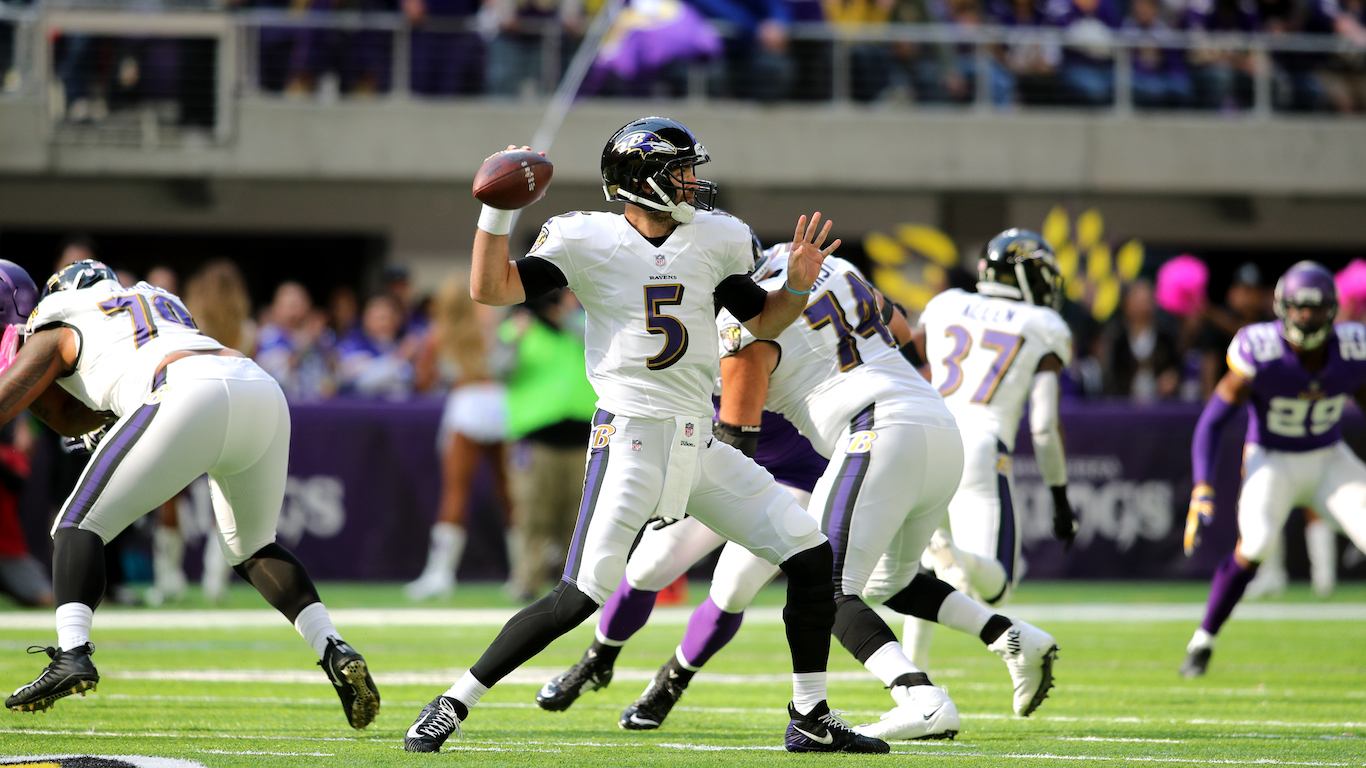
3. Baltimore Ravens: Joe Flacco
> Years with Ravens: 2008-present
> Stats with Ravens: 35,780 pass yds./200 TDs
> Record with team: 92-62
> Achievements with team: Super Bowl champion
> Runner up: Steve McNair
The University of Delaware is not exactly a football factory, but the Blue Hens can be proud of alumnus Joe Flacco, the best quarterback in the history of the Baltimore Ravens. He is the Ravens’ all-time leading passer in yards (35,577), touchdown passes (198), completions (3,242), and attempts (5,244). In 2016, he threw for a single-season team-record 4,317 yards.
Flacco led Baltimore to the Super Bowl XLVII title in 2012 and was named the game’s MVP.
Flacco’s 10 playoff wins are the second-most among quarterbacks since he entered the NFL in 2008, behind Tom Brady’s 11.
Also noteworthy: Flacco has 26 career game-winning drives (24 regular season and 2 playoff) in the fourth quarter or overtime.

4. Buffalo Bills: Jim Kelly
> Years with Bills: 1986-1996
> Stats with Bills: 35,467 pass yds./237 TDs
> Record with team: 101-59
> Achievements with team: 5x Pro-Bowl, All-Pro, Hall of Fame
> Runner up: Jack Kemp
The Buffalo Bills have had very good quarterbacks in their history, including Joe Ferguson and Jack Kemp. But Jim Kelly gets the nod as the Bills’ greatest signal caller.
Kelly was part of the storied 1983 NFL draft that produced, among other notable quarterbacks, Dan Marino, John Elway, and Todd Blackledge. After a stint in the United States Football League, Kelly went to the snowy climes of Buffalo.
He directed a high-powered offense featuring running back Thurman Thomas and wide receiver Andre Reed and took the Bills to four straight Super Bowls on his way to the football Hall of Fame in 2002. In 11 seasons in Buffalo, Kelly led the Bills to the playoffs eight times.
Eight times in his career Kelly passed for more than 3,000 yards in a season. His 35,467 career passing yards ranks 10th in NFL history, and his 2,874 completions ranks eighth.
Kelly has had his share of heartache and physical challenges. He lost his young son Hunter to Krabbe’s disease, and he himself was diagnosed with oral cancer in 2014. Kelly beat the disease, and he credits the support from Bills’ fans for helping him regain his health.
[in-text-ad-2]
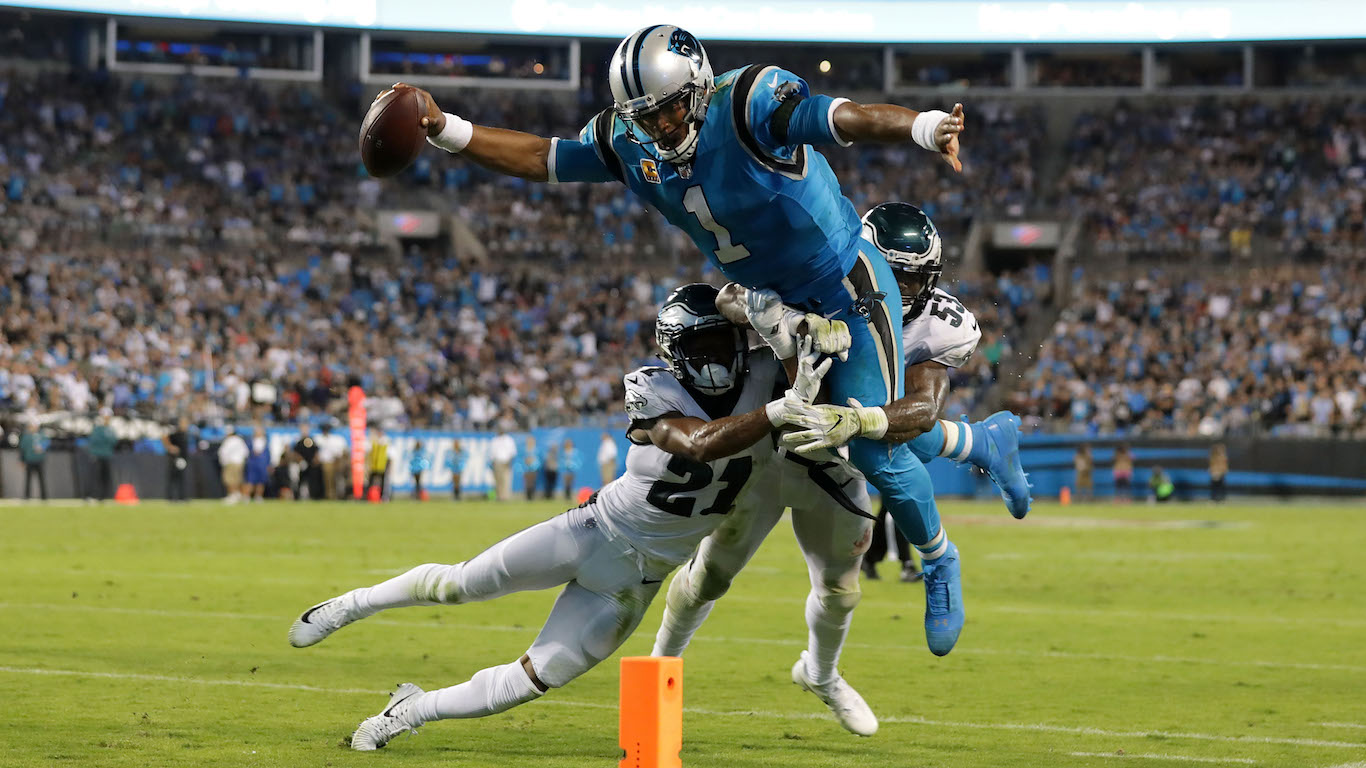
5. Carolina Panthers: Cam Newton
> Years with Panthers: 2011-present
> Stats with Panthers: 25,074 pass yds./158 TDs
> Record with team: 62-45-1
> Achievements with team: 3x Pro-Bowl, All-Pro, MVP
> Runner up: Jake Delhomme
At 6’5″, 245 pounds, the imposing Cam Newton is rapidly making his mark in the NFL.
In his rookie year, Newton broke all-time NFL rookie records for passing and rushing yards. He became the first NFL quarterback to throw for 400 yards in his first game. Newton went on to become the first rookie quarterback to throw for 4,000 yards in a season. He also ran for 14 touchdowns, more in a single season than any quarterback in NFL history.
In 2015, Newton threw 35 touchdown passes against 10 interceptions and capped off that campaign by winning the MVP and leading the Panthers to a 15–1 record and a trip to Super Bowl 50.
Newton is the only player in the modern era to be awarded the Heisman Trophy, win a national championship with Auburn University, and become the first overall pick in an NFL draft within a one-year span.
Newton is already the all-time leader in rushing touchdowns by a quarterback with 54.

6. Chicago Bears: Sid Luckman
> Years with Bears: 1939-1950
> Stats with Bears: 14,686 pass yds./137 TDs
> Record with team: 98-32-3
> Achievements with team: 3x Pro-Bowl, 5x All-Pro, 4x NFL champion, Hall of Fame
> Runner up: Jim McMahon
Sid Luckman helped define the role of the modern quarterback.
Luckman’s signal calling, passing skills, and direction of the T-formation attack were instrumental in the Bears’ 73-0 shellacking of the Washington Redskins in the 1940 NFL Championship. It remains the most one-sided result in NFL postseason history. That game game changed the way teams run their offense.
During the 1943 season, Luckman threw for an NFL-record seven touchdown passes against the New York Giants. In the NFL Championship Game that year, Luckman tossed five touchdown passes against the Washington Redskins. That season was Luckman’s best as he passed for 28 touchdowns and threw for 2,194 yards.
The Bears were truly the Monsters of the Midway under Luckman’s direction in the 1940s. They won NFL titles in 1940, 1941, 1943, and 1946. The Bears have only played in four NFL championship games since the Luckman era and have won twice.
[in-text-ad]
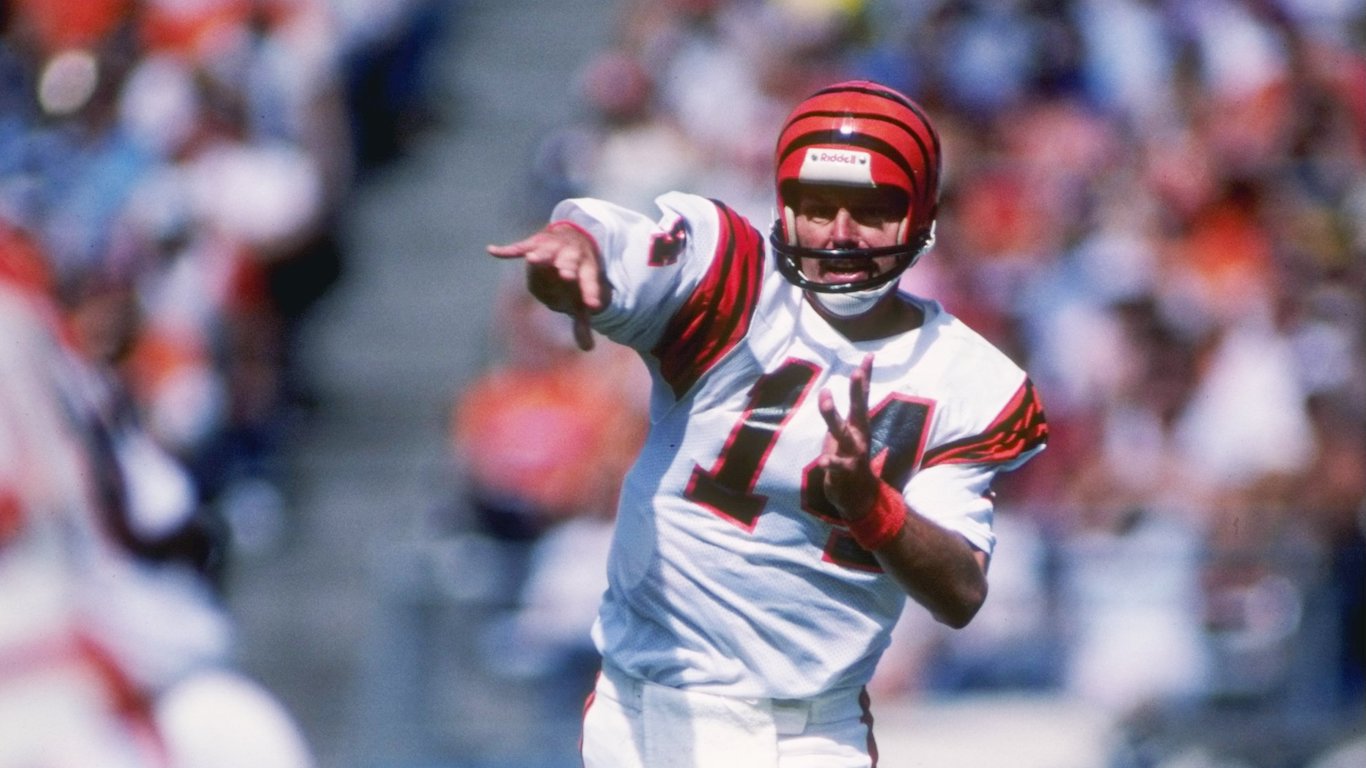
7. Cincinnati Bengals: Ken Anderson
> Years with Bengals: 1971-1986
> Stats with Bengals: 32,838 pass yds./197 TDs
> Record with team: 91-81
> Achievements with team: 4x Pro-Bowl, All-Pro, MVP
> Runner up: Boomer Esiason
Selecting the greatest Cincinnati Bengals’ quarterback was a tough call. Both Ken Anderson and Boomer Esiason won the league’s most valuable player award and both took the Bengals to the Super Bowl. But Anderson, who spent his entire 16-year career with the Bengals, gets the edge because his lifetime record is better.
Anderson exercised pinpoint accuracy in leading the Bengals. He completed more than 64% of his passes in three seasons, and in four he had a quarterback rating for the full season of 90 points or better.
His greatest season was 1981. Anderson threw for 29 touchdowns versus 10 interceptions and had 3,754 yards through the air to win league MVP and take the Bengals to the Super Bowl.
Anderson is also the team’s career leader in passing yards (32,838) and passing touchdowns (197).

8. Cleveland Browns: Otto Graham
> Years with Browns: 1946-1955
> Stats with Browns: 23,584 pass yds./174 TDs
> Record with team: 104-17-4
> Achievements with team: 5x Pro-Bowl, 7x All-Pro, 3x NFL champion, Hall of Fame
> Runner up: Frank Ryan
No list of all-time great quarterbacks of any kind would be complete without Otto Graham.
Graham took the Browns to league championship games in the All-America Football Conference (AAFC) and then in the National Football League every year between 1946 and 1955 — and the Browns won seven of them.
Most of Graham’s records have been surpassed, but one has not. Graham has the highest winning percentage of any quarterback in NFL history with a minimum of 35 wins at .788 (61 wins to 16 losses).
Paul Brown, who coached Graham in Cleveland, once said about the quarterback: “The test of a quarterback is where his team finishes. By that standard, Otto Graham was the best of all time.”
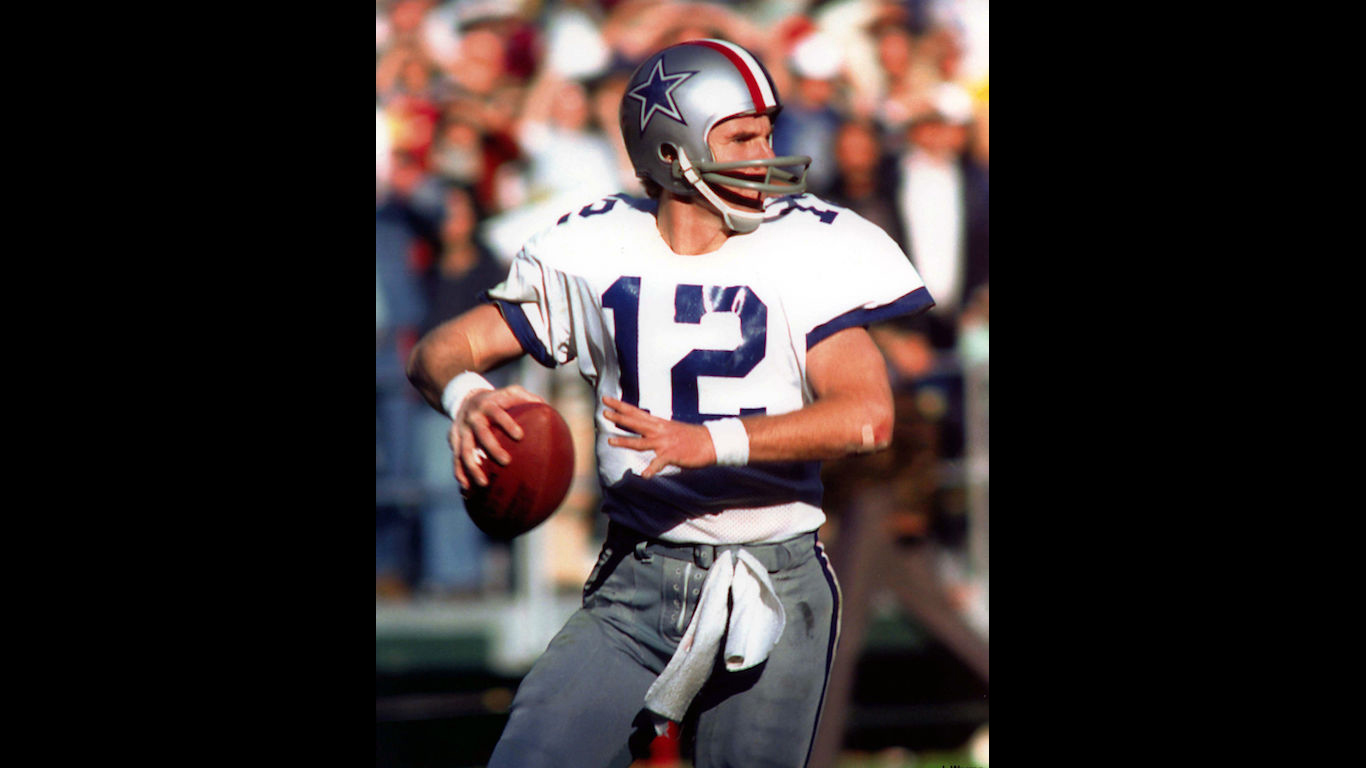
9. Dallas Cowboys: Roger Staubach
> Years with Cowboys: 1969-1979
> Stats with Cowboys: 22,700 pass yds./153 TDs
> Record with team: 85-29
> Achievements with team: 6x Pro-Bowl, 2x Super Bowl champion, Hall of Fame
> Runner up: Troy Aikman
The Dallas Cowboys have a rich history at quarterback with Troy Aikman, Tony Romo, and Don Meredith to name just a few. But there is only one Captain America, and that is Roger Staubach.
Staubach won the Heisman Trophy while playing at the Naval Academy, so you knew he had the leadership skills. Even so, Coach Tom Landry didn’t make him the starting quarterback for the Cowboys until a scheme to alternate starts with Craig Morton in 1971 failed. Staubach, then 29 years old, became the sole starter. Staubach’s combination of scrambling and passing skills, and his knack for making big plays in the most desperate situations, made him a Cowboy immortal.
With Staubach helming the offense, America’s Team reached the conference championship game six times in nine seasons, played in the Super Bowl four times, and won twice. Staubach was the MVP in the Cowboys’ first Super Bowl victory in 1972, completing 12 of 19 passes and two touchdowns.
When he retired in 1979, the six-time Pro Bowler was the second-leading passer in team history with 22,700 yards and 153 touchdowns. He also ran for 2,264 yards and 20 touchdowns.
[in-text-ad-2]
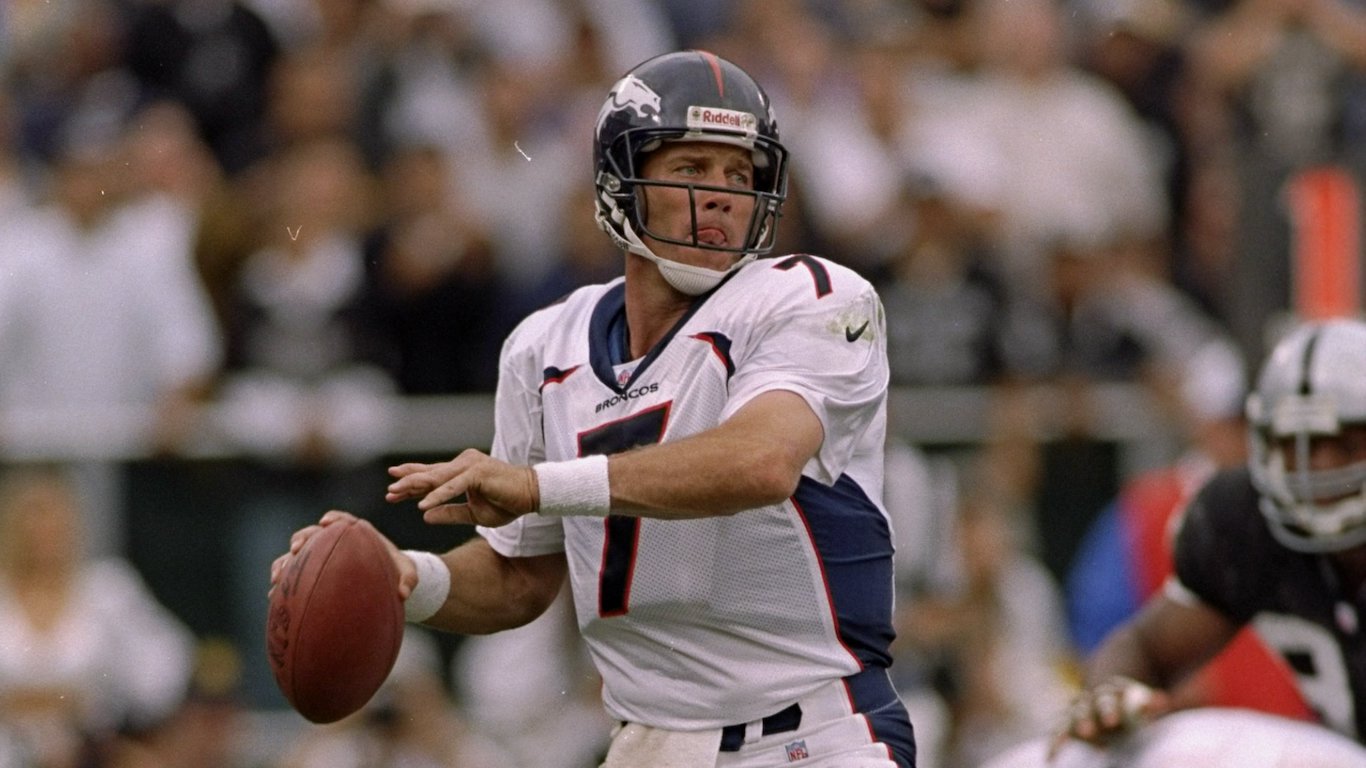
10. Denver Broncos: John Elway
> Years with Broncos: 1983-1998
> Stats with Broncos: 51,475 pass yds./300 TDs
> Record with team: 148-82-1
> Achievements with team: 9x Pro-Bowl, MVP, 2x Super Bowl champion, Hall of Fame
> Runner up: Peyton Manning
NFL historians point to the 1983 draft as the richest of all time for quarterbacks — and there was no quarterback who came out of that draft greater than John Elway.
Elway led the Broncos to five Super Bowl appearances and two Super Bowl victories. He won 148 games in his 16-year career, ranked second in passing yardage (51,475), and was third in touchdown passes (300) by the time he retired.
Elway also engineered 47 comeback wins in his career. But he is most famous for “The Drive” in the AFC Championship Game in 1987 that has become folklore in Denver. With 5:32 to play and trailing 20-13 to the Cleveland Browns, Elway led the Broncos on a 98-yard scoring march that tied the game that the Broncos eventually won in overtime.
The Broncos ended up losing the Super Bowl to the Giants that year, and Elway would not shake the big-game choker label until Denver won back-to-back Super Bowls in 1998 and 1999. As befitting a player of his stature, Elway ended his 16-year career by defeating the Atlanta Falcons in Super Bowl XXXIII by throwing for 336 yards and a touchdown.

11. Detroit Lions: Bobby Layne
> Years with Lions: 1950-1958
> Stats with Lions: 15,710 pass yds./118 TDs
> Record with team: 53-29-2
> Achievements with team: 4x Pro-Bowl, 2x All-Pro, 3x NFL champion
> Runner up:tthew Stafford
There was a time when the Detroit Lions ruled the NFL, and Bobby Layne was their helmsman. In the 1950s, Layne directed the Lions to three NFL titles, the last one in 1957. That is also the last NFL title the Lions won.
At the time of his death in 1986, Layne held the Lions’ career records for passing attempts (2,193), completions (1,074), passing yards gained (15,710), and touchdown passes (118). Much of that output occurred late in the games, as Layne specialized in late-game rallies. Layne, who entered the football Hall of Fame in 1986, is often cited as the innovator of the two-minute offense. His last-second touchdown pass won the 1953 NFL Championship for the Lions.
”Bobby Layne never lost a game,” his friend and former teammate Doak Walker once said. ”Sometimes, time just ran out on him.”
Layne was a colorful, quotable character, and a gunslinger before Brett Favre became associated with the term.
He also liked a good time and was not bashful about it. Layne’s antics once got him arrested for drunk driving. He beat the charge, claiming the arresting officer mistook his Texas drawl for slurred speech.
There is also an urban legend associated with Layne. When the Lions traded him two games into the 1958 season to the Pittsburgh Steelers, it was claimed a seething Layne said the Lions would not win for another 50 years.
[in-text-ad]

12. Green Bay Packers: Brett Favre
> Years with Packers: 1992-2007
> Stats with Packers: 61,655 pass yds./442 TDs
> Record with team: 160-93
> Achievements with team: 9x Pro-Bowl, 3x MVP, Super Bowl champion, Hall of Fame
> Runner up: Aaron Rodgers
The Green Bay Packers have been blessed with some of the best quarterbacks to ever play the game. Bart Starr or Aaron Rodgers would have been fine selections as the best franchise quarterback of all time for the Packers, but because of his innovative abilities and gunslinger mentality, we have picked Brett Favre.
Favre restored the Packers to glory in leading them to the 1997 Super Bowl victory, their first in almost 30 years.
During his Hall of Fame career, Favre threw for NFL-records 71,838 yards and 508 touchdowns, marks later eclipsed by Peyton Manning. Befitting his reputation as a gunslinger, Favre still holds the record for most career interceptions (336). Most of these totals were with the Packers. Favre also later played for the New York Jets and Minnesota Vikings.
Favre won his Most Valuable Player awards in succession (1995-97) with the Packers.
He was also durable, starting an NFL record of 297 consecutive regular-season games.

13. Houston Texans: Matt Schaub
> Years with Texans: 2007-2013
> Stats with Texans: 23,221 pass yds./124 TDs
> Record with team: 46-42
> Achievements with team: 2x Pro-Bowl
> Runner up: David Carr
The Houston Texans have not been around that long and have yet to produce a legendary quarterback, but Matt Schaub served the team well in the seven years he played there.
Schaub has been selected twice to the Pro Bowl and has thrown 124 touchdown passes for Houston.
Schaub threw for 20 touchdown passes or more in three seasons for the Texans. His best season was in 2009, when he led the league in passing yards (4,770), passing yards per game (298), and passes completed (396). Schaub holds all Texans’ records in every passing category.
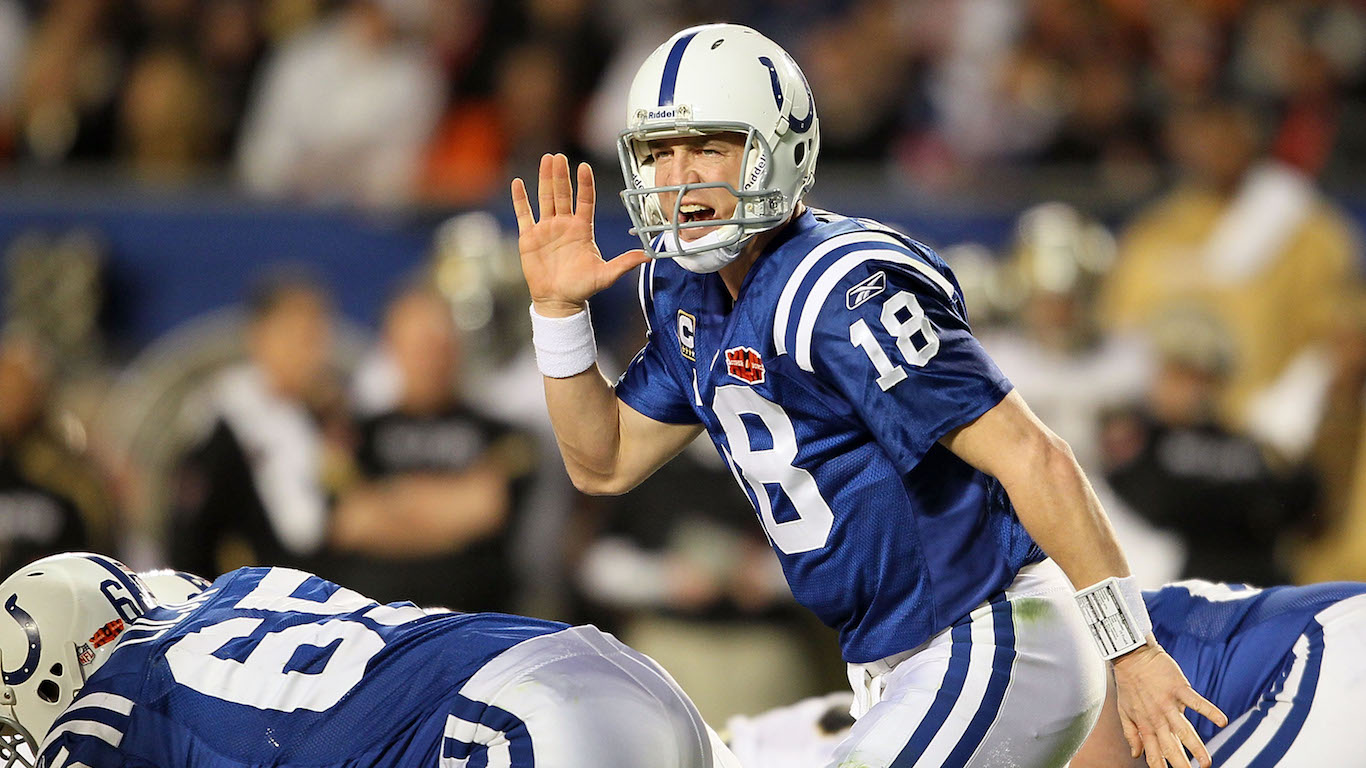
14. Indianapolis Colts: Peyton Manning
> Years with Colts: 1998-2010
> Stats with Colts: 54,828 pass yds./399 TDs
> Record with team: 141-67
> Achievements with team: 11x Pro-Bowl, 5x All-Pro, 4x MVP, Super Bowl champion
> Runner up: Johnny Unitas
The Colts are a tricky team for choosing best quarterback. Without question, Peyton Manning is the best ever to play for the Colts after they moved to Indianapolis in 1984. But when they were still in Baltimore, there is no doubt that Johnny Unitas was the greatest signal caller for the team. The numbers, though, tilt in Peyton Manning’s favor, barely.
Manning passed for 54,828 yards and 399 touchdowns, and led the Colts to victory over the Chicago Bears in the 2007 Super Bowl. Of all the truly great seasons Manning had with the Colts, the 2004 campaign has to be recalled to be believed. That year, Manning threw 49 touchdown passes for 4,557 yards and tallied a quarterback rating of 121.1.
Manning won the MVP three times with the Colts and a fourth with the Broncos.
Unitas bears mention for his on-field achievements and his place as a historical figure in the NFL. He directed the Baltimore Colts to the NFL title in 1958 and 1959, and he helped the Colts win Super Bowl V in 1972. Unitas was the Colts quarterback in the famous 1958 title game between the Colts and the Giants that would be called the “greatest game ever played.” The growth of the popularity of the sport on television is credited to this game.
[in-text-ad-2]
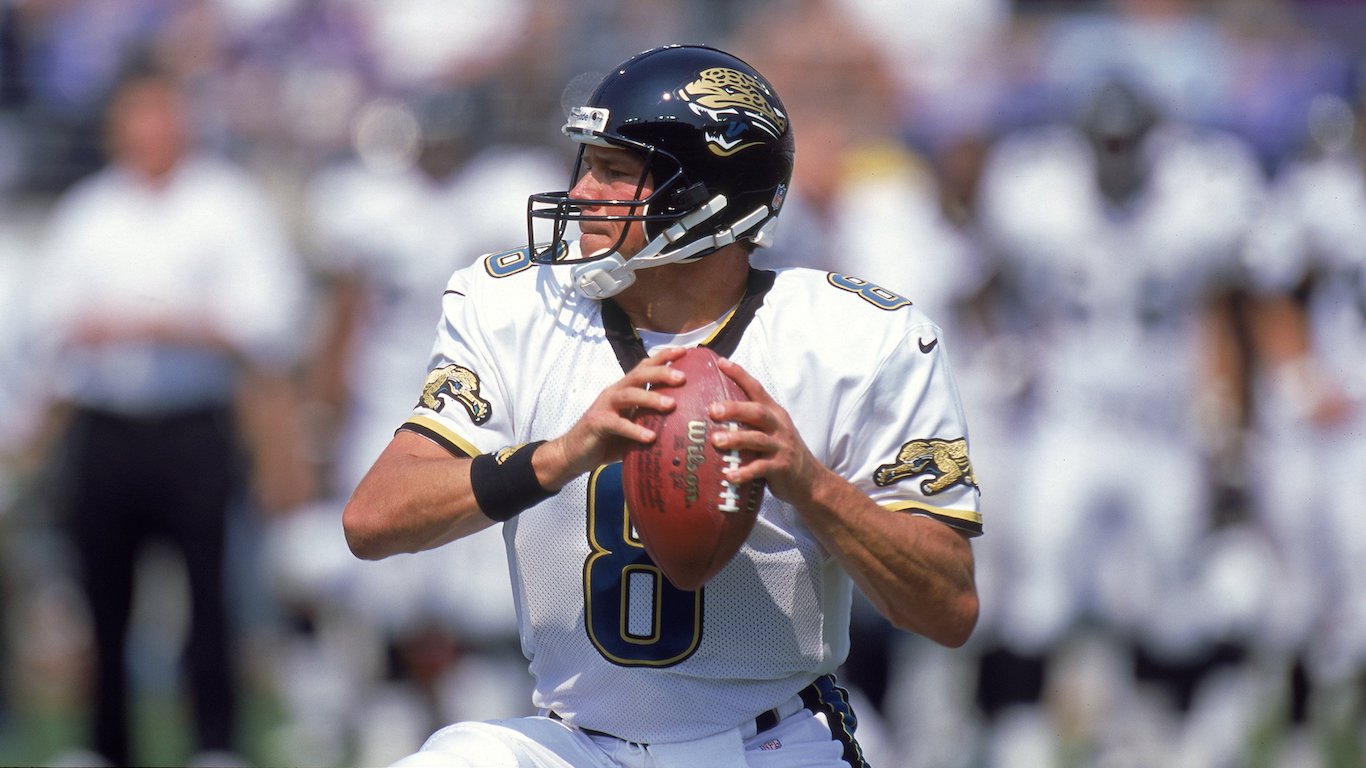
15. Jacksonville Jaguars: Mark Brunell
> Years with Jaguars: 1995-2003
> Stats with Jaguars: 25,698 pass yds./144 TDs
> Record with team: 63-54
> Achievements with team: 3x Pro-Bowl
> Runner up: David Garrard
Mark Brunell holds all the passing records for the Jacksonville Jaguars. He has the most touchdown passes (144), passing yards (25,698), and most completions (2,184). The left-hander from the University of Washington has also played more games as the Jacksonville signal caller than any other quarterback.
His best season at Jacksonville was in his second year with the Jaguars in 1996, when he led the league with 4,367 passing yards.
Brunell directed Jacksonville to its best regular-season record of 13-2 in 1999. Under Brunell, the Jags reached the playoffs four times and got to the AFC Championship Game in 1996 before falling to the New England Patriots.

16. Kansas City Chiefs: Len Dawson
> Years with Chiefs: 1962-1975
> Stats with Chiefs: 28,507 pass yds./237 TDs
> Record with team: 93-56-8
> Achievements with team: 7x Pro-Bowl, 2x All-Pro, AFL Champion, Super Bowl champion, Hall of Fame
> Runner up: Trent Green
Hall of Famer Len Dawson was at the controls of the moving-pocket offense of the Kansas City Chiefs, who held sway in the American Football Conference in the late 60s and early 70s.
Few players are more closely associated with a franchise than Dawson. He’s been with the Chiefs organization since 1962, the final year the team played in Dallas as the Texans. Dawson led that team to the American Football League Championship. He led the Chiefs to AFL titles in 1966 and 1969. And he was the Chiefs quarterback when they played in the first Super Bowl in 1967.
Dawson was the MVP of Kansas City’s Super Bowl victory over the favored Minnesota Vikings in 1970. He was under more than the usual pressure for that game because he had been linked to a gambling investigation in the days leading up to the game.
More than 40 years after he retired, Dawson is the franchise leader in career passing yards (28,507) and touchdowns (237).
[in-text-ad]
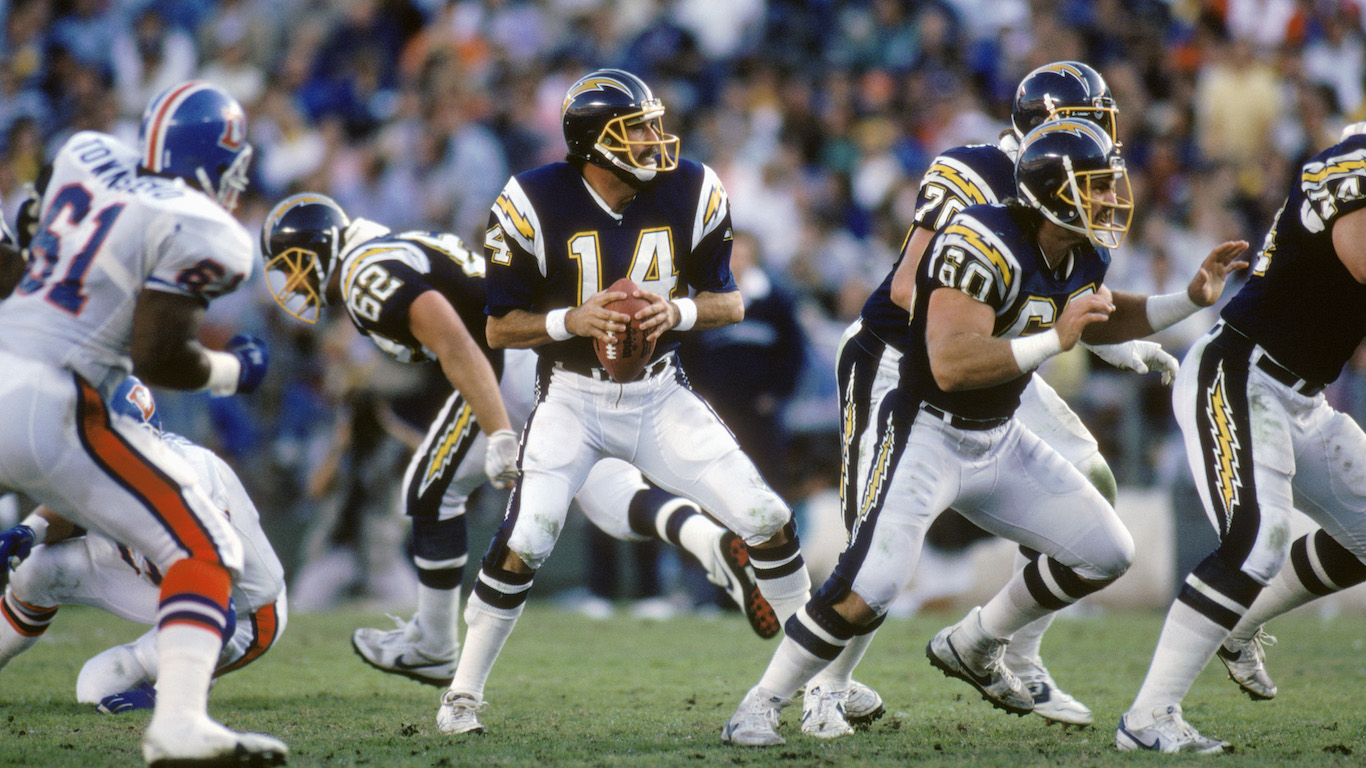
17. Los Angeles Chargers: Dan Fouts
> Years with Chargers: 1973-1987
> Stats with Chargers: 43,040 pass yds./254 TDs
> Record with team: 86-84-1
> Achievements with team: 6x Pro-Bowl, 2x All-Pro, Hall of Fame
> Runner up: Philip Rivers
Dan Fouts made Air Coryell operational when the Chargers played in San Diego. Fouts was the quarterback at San Diego when coach Don Coryell shifted the offense into a free-wheeling, pass-often scheme.
“The first thing in our offense was always the bomb,” said Hall of Famer Fouts in Ron Jaworski’s book “The Games That Changed the Game.” “It was built into almost every pass play, where the quarterback initially looks for that chance to hit the big one.”
And Fouts hit the big one often. Fouts had 254 touchdown passes, many of them to receivers such as Charlie Joiner, Kellen Winslow, Wes Chandler, and John Jefferson. Fouts led the league six times in passing yards per game. He topped the league in passing yards for four straight years ending in 1982. His best year was 1981, when he completed 360 passes for 4,802 yards (both tops in league) and 33 touchdown passes.
Fouts is second on the Chargers all-time list in passing yards (43,040), completions (3,297), and touchdown passes (254).

18. Los Angeles Rams: Kurt Warner
> Years with Rams: 1998-2003
> Stats with Rams: 14,447 pass yds./102 TDs
> Record with team: 35-15
> Achievements with team: 3x Pro-Bowl, 2x All-Pro, 2x MVP, Super Bowl champion
> Runner up: Bob Waterfield
Kurt Warner went from bagging groceries to playing quarterback in the National Football League. If that sounds like a movie starring Kevin Costner, that understandable.
Warner was not drafted. He played Arena Football and played for NFL Europe before he signed with the St. Louis Rams. He would eventually take the Rams and their “Greatest Show on Turf” to their only Super Bowl win in Super Bowl XXXIV, passing for a Super Bowl record 414 yards and winning the MVP.
Warner also has two regular-season MVPs to his credit.
Just to show his time with the Rams was not a fluke, Warner led the 2008 Arizona Cardinals to their first Super Bowl appearance in XLIII.
19. Miami Dolphins: Dan Marino
> Years with Dolphins: 1983-1999
> Stats with Dolphins: 61,361 pass yds./420 TDs
> Record with team: 147-93
> Achievements with team: 9x Pro-Bowl, 3x All-Pro, MVP, Hall of Fame
> Runner up: Bob Griese
Hall of Famer Dan Marino is another member of the storied quarterback class of 1983, and some might say he is its valedictorian. He is regarded by many NFL historians as the greatest passer to ever play in the NFL, and was known for his quick release and powerful arm.
Marino was first quarterback to pass for more than 5,000 yards in one season when he threw for 5,084 in 1984. He was the league MVP that year. The Hall of Famer threw for 61,361 yards and 420 touchdowns to receivers like the Marks Brothers (Mark Duper and Mark Clayton). Marino holds all of the passing records at Miami.
The Dolphins under Marino went to the playoffs 10 times and got to one Super Bowl, but were blown out by the San Francisco 49ers in Super Bowl XIX.
[in-text-ad-2]

20. Minnesota Vikings: Fran Tarkenton
> Years with Vikings: 1961-1966, 1972-1978
> Stats with Vikings: 33,098 pass yds./239 TDs
> Record with team: 91-73-6
> Achievements with team: 5x Pro-Bowl, All-Pro, MVP, Hall of Fame
> Runner up: Daunte Culpepper
Fran Tarkenton was famous as an undersized scrambler; he’s also famous for being a winner.
Tarkenton had two separate stints with the Minnesota Vikings after a period with the New York Giants. In his second tenure with the purple-clad Vikings, Tarkenton took them to three Super Bowls, and Minnesota lost all of them.
During his second tenure with the Vikings, Tarkenton was named MVP of the NFL in 1975, when he was 35 years old. He led the league that year with 25 touchdown passes and 273 completions.
In his final season in 1978, Tarkenton completed 345 passes for 3,468 yards, both career highs.
By the time he retired, Tarkenton owned every major quarterback record. He still holds the Vikings records for passing yards (33,098), completions (2,635), and touchdown passes (239). He was inducted into the Hall of Fame in 1986.
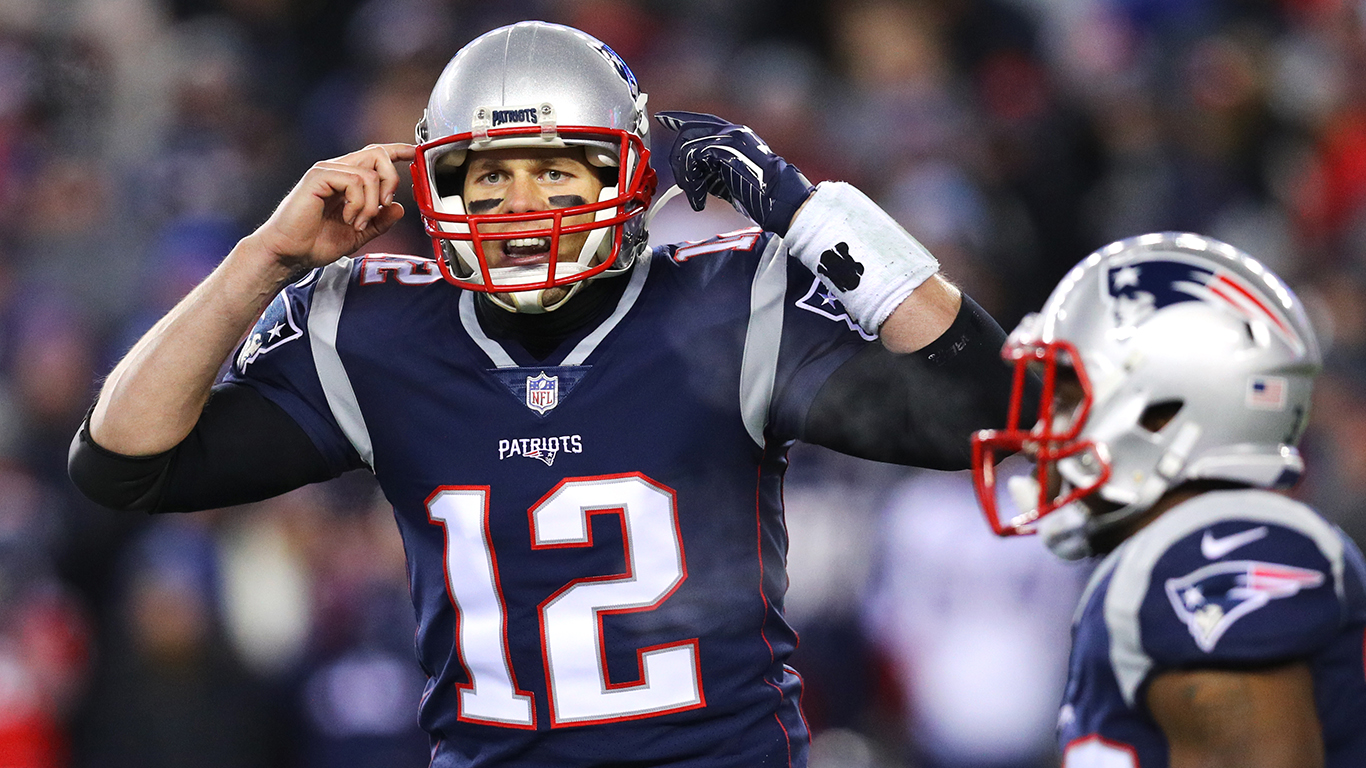
21. New England Patriots: Tom Brady
> Years with Patriots: 2000-present
> Stats with Patriots: 66,159 pass yds./488 TDs
> Record with team: 196-55
> Achievements with team: 13x Pro-Bowl, 3x All-Pro, 2x MVP, 5x Super Bowl champion
> Runner up: Drew Bledsoe
In an outcome about as predictable as an election in North Korea, Tom Brady is the greatest quarterback in the history of the New England Patriots.
Brady has been so brilliant for so long it is hard to remember if the Pats ever had anyone else play the position. The Patriots actually had good quarterbacks such as Drew Bledsoe, Tony Eason, and Steve Grogan, who took the Patriots to their first two Super Bowls, which New England lost. Brady, a sixth-round draft pick in 2000, replaced an injured Bledsoe in 2001 to lead the Patriots to a Super Bowl championship.
We know the rest of the story of the living legend, which includes some scandals like Deflategate, the controversial “tuck rule” in a divisional playoff game against the Oakland Raiders in 2001, and the alleged power struggle that involved coach Bill Belichick and owner Robert Kraft.
This Sunday, the 40-year-old Brady defied father time by leading the Patriots back from a 20-10 deficit in the fourth quarter to win the AFC Championship Game to send his team to the Super Bowl for the 10th time.
Brady’s trophy case is overflowing with honors: five-time Super Bowl champion; four-time Super Bowl MVP; two-time regular season MVP;13-time Pro Bowler, three-time All-Pro.
Even though he played in the same era as Peyton Manning, Brady has been atop of the NFL passing leaders in touchdown passes four times, and passing yardage three times. He’s posted a full-season quarterback rating of more than 100 six times.
Not surprisingly, he is the team’s all-time leader in every passing category, including completions (5,629), touchdown passes (488), and passing yards (66,159).
Of all the great seasons he’s had, 2007 might have been his best. He threw 50 touchdown passes and rolled up 4,806 yards, both of which led the league, and he had a career-highest quarterback rating of 117.2.
[in-text-ad]
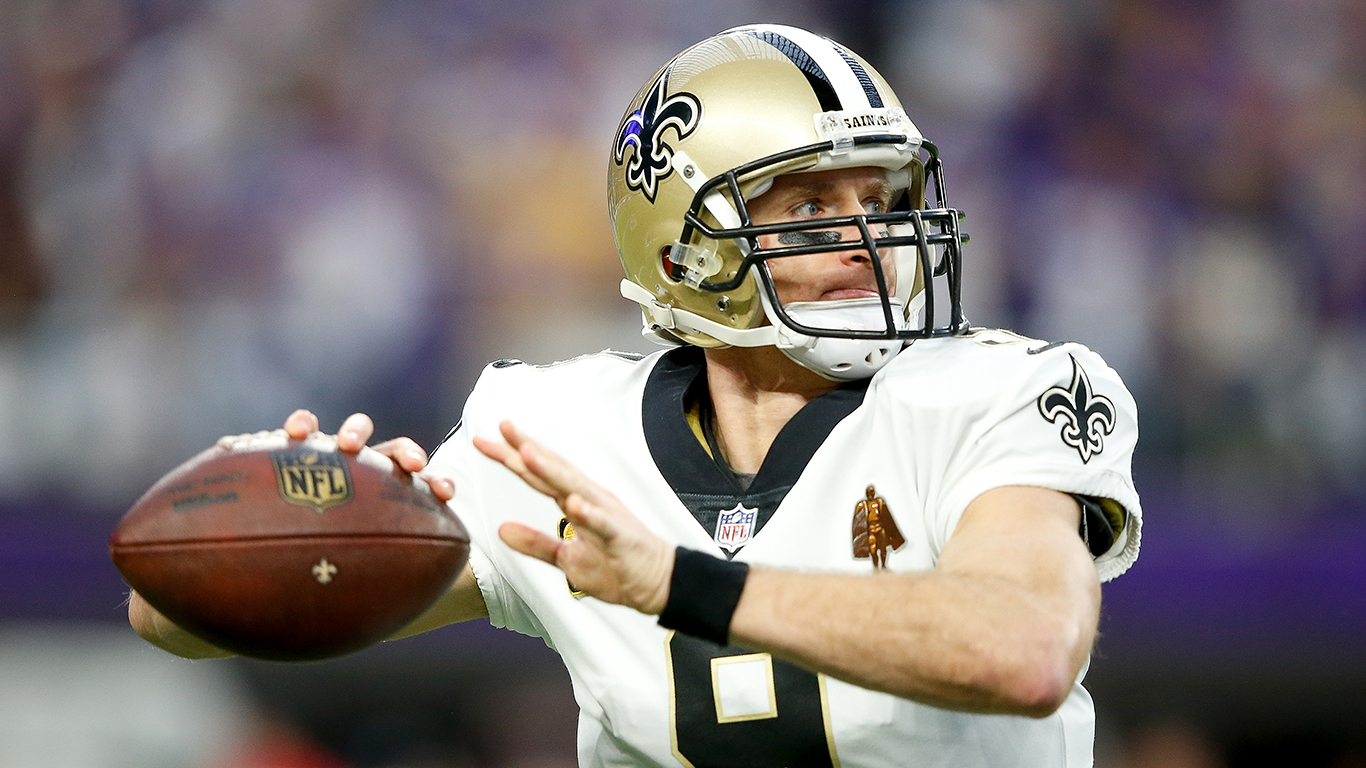
22. New Orleans Saints: Drew Brees
> Years with Saints: 2006-present
> Stats with Saints: 58,097 pass yds./408 TDs
> Record with team: 112-78
> Achievements with team: 10x Pro-Bowl, All-Pro, Super Bowl champion
> Runner up: Archie Manning
Drew Brees is too short and too small to play professional football — a claim the New Orleans Saints and Brees beg to disagree.
Brees has thrown for 5,000 yards five times, more than any other quarterback in league history. His 5,476 yards passing in the 2011 season is second by one yard to Peyton Manning’s single-season mark.
After Brees left San Diego following the 2005 season, he got to work setting records in the Big Easy. He’s led the league in passing yards seven times and touchdown passes four times. His highest TD total was 46 in 2011. Six times Brees has led the league in completions.
Brees led the Saints to their only Super Bowl victory in 2010 by completing 32 of 39 passes for 288 yards and two touchdowns. It was a great moment for Brees, who came from San Diego to New Orleans shortly after Hurricane Katrina had ravaged the city and became deeply involved in its recovery.

23. New York Giants: Eli Manning
> Years with Giants: 2004-present
> Stats with Giants: 51,682 pass yds./339 TDs
> Record with team: 111-103
> Achievements with team: 4x Pro-Bowl, 2x Super Bowl champion
> Runner up: Phil Simms
Few quarterbacks have had a more puzzling relationship with their fan base than Eli Manning. His regular season record is mediocre; he throws too many interceptions (he’s led the league three times); and he has little mobility. And that is what his supporters say.
But when the Giants oafishly tried to replace him during this recent dismal season, fans rose up in righteous indignation on talk radio. Giants fans know there is no one better when the chips are down.
Beneath that aw-shucks exterior Manning has the nerves of a cat burglar, and he exhibited his coolness under pressure in two memorable postseason runs. In both cases, he took a wild-card team to a Super Bowl championship, winning eight postseason games along the way, all of them on the road.
In the 2008 Super Bowl, Manning led the Giants to an upset victory over the previously undefeated New England Patriots. Four years later, he beat the Patriots again in the Super Bowl. In both games, Peyton’s little brother was the MVP.
During those two post-season runs, Manning threw 15 touchdown passes and had just two interceptions. His postseason quarterback rating in 2012 was 103.3.
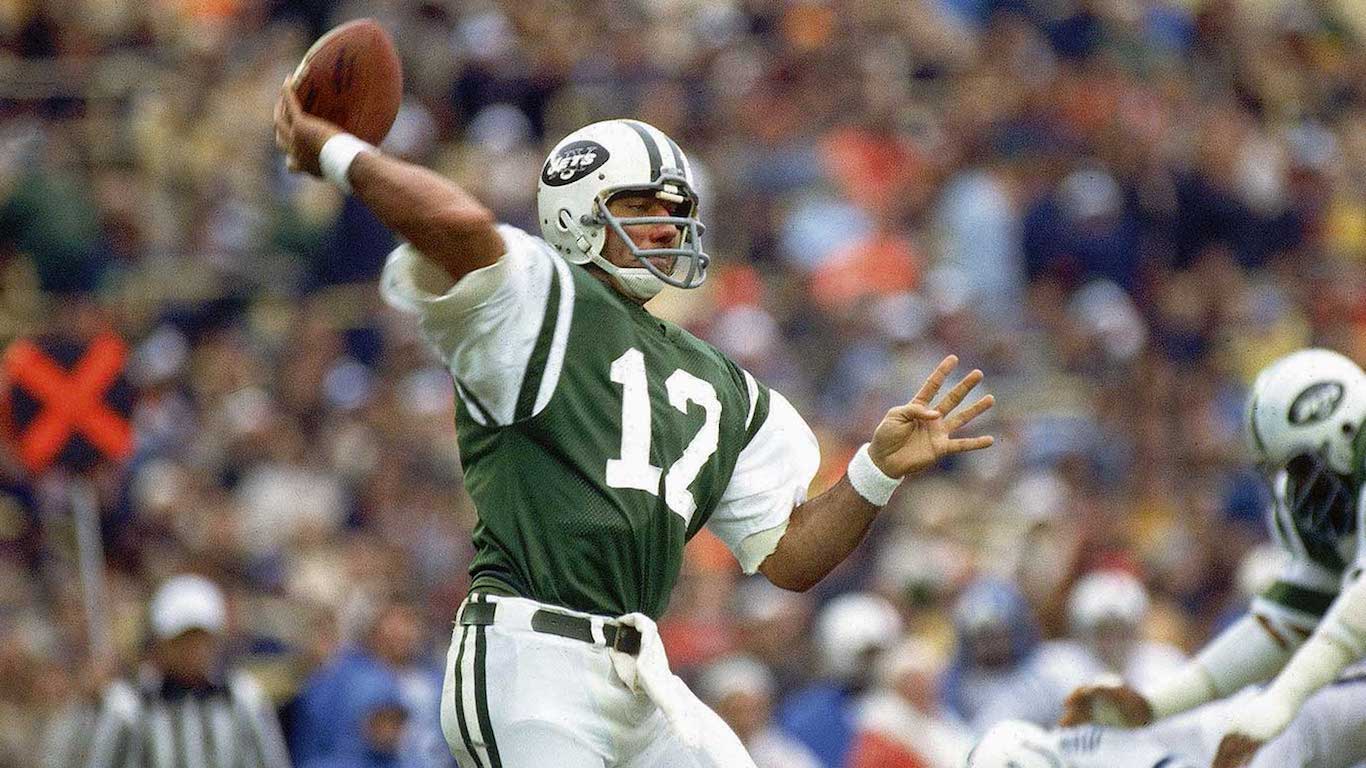
24. New York Jets: Joe Namath
> Years with Jets: 1965-1976
> Stats with Jets: 27,057 pass yds./170 TDs
> Record with team: 60-61-4
> Achievements with team: 5x Pro-Bowl, All-Pro, Super Bowl champion, Hall of Fame
> Runner up: Ken O’Brien
If ever a man was made for a moment, it was Joe Namath. As the anti-hero zeitgeist swept the nation in the 60s, Namath arrived in the NFL and immediately challenged all conventions. Broadway Joe grew his hair long, wore white shoes, sported a Fu Manchu mustache, cloaked himself in full-length mink coats, squired around models and actresses, stayed out late, and hobnobbed with people of questionable character. He even got on President Richard Nixon’s enemies list.
Even his first contract was outsized. He signed in 1965 a three-year deal with the New York Jets worth $427,000, a record at the time. He would eventually win the AFL rookie of the year and start to compile numbers. In 1967, he became the first quarterback to throw for more than 4,000 yards in one game.
This was merely the prologue. The Jets reached the Super Bowl in 1969, and Namath famously guaranteed that the Jets would beat the Baltimore Colts, who were an 18-point favorite. When he delivered on his guarantee with a victory for the ages, and won the game MVP, the legend took on an even greater dimension. The AFL had parity with the NFL.
Namath’s gimpy knees would limit his career, which statistically seems mediocre in terms of win-loss percentage. He actually had more interceptions than touchdown passes in his Jets career (215-170). But his importance as a historical figure in professional football imbues him with greatness.
[in-text-ad-2]

25. Oakland Raiders: Ken Stabler
> Years with Raiders: 1970-1979
> Stats with Raiders: 19,078 pass yds./150 TDs
> Record with team: 69-26-1
> Achievements with team: 4x Pro-Bowl, All-Pro, MVP, Super Bowl champion
> Runner up: Rich Gannon
The Oakland Raiders lived up to their bellicose mascot when Ken Stabler played for them in the 1970s. Those were the “Just-win, baby” Raiders of owner Al Davis, who was not above signing players of dubious moral character to play for him. Stabler was not one of those, but he was tough as nails and embodied the grittiness typical of quarterbacks in the 1970s.
Stabler played 10 years with the Raiders, and though he had only seven more touchdowns than interceptions in his career, his teams never had a losing season. He took the Raiders to the playoffs six times, and his postseason record of 7-4 included a Super Bowl victory in 1977. In his postseason career he had 19 touchdown passes and 11 interceptions.
His greatest season was 1974, when he won the MVP and led the league in touchdown passes with 26. Stabler remains the Raiders all-time leader in passing yardage (19,078) and touchdown passes (150).
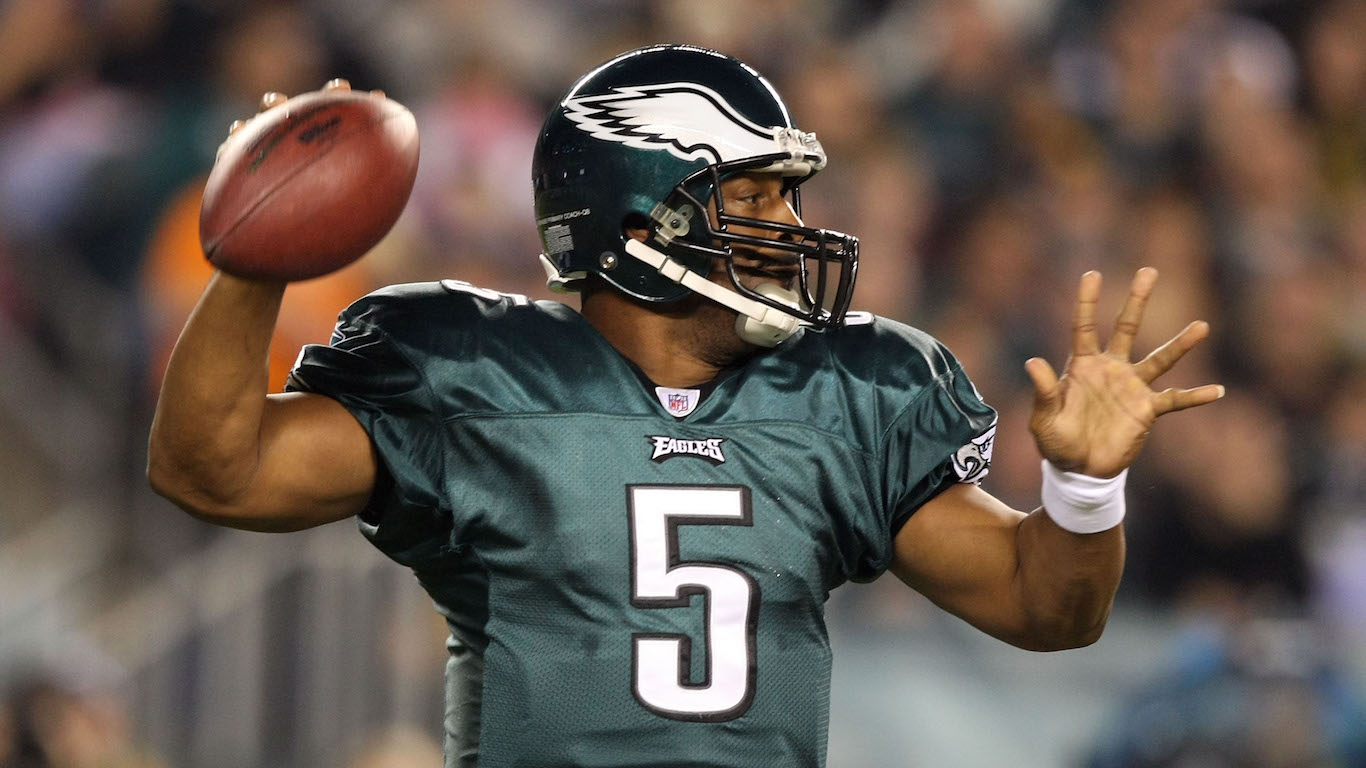
26. Philadelphia Eagles: Donovan McNabb
> Years with Eagles: 1999-2009
> Stats with Eagles: 32,873 pass yds./216 TDs
> Record with team: 92-49-1
> Achievements with team: 6x Pro-Bowl
> Runner up: Tommy Thompson
Donovan McNabb came close to knocking off the New England Patriots in 2005 and bringing the City of Brotherly Love a Super Bowl title. But the Patriots prevailed with a 24-21 victory.
McNabb was one of the change agents for Philadelphia after he was drafted by the Eagles in 1999. The Eagles reached the NFC Conference Championship Game from 2001 to 2003, but lost each time. McNabb had his best year in 2004, completing 300 out of 469 (64%) passes for 3,875 yards, 31 touchdowns, and eight interceptions.
Although Super Bowl success has eluded the Eagles, and Philadelphia has not won an NFL title since 1960, the Eagles have had good quarterbacks, including Randall Cunningham and Ron Jaworski. And Carson Wentz might yet become the best of all. However, McNabb is still the Eagles leader in wins (92), completions (2,801), passing yards (32,873), and touchdown passes (216).
[in-text-ad]
27. Pittsburgh Steelers: Terry Bradshaw
> Years with Steelers: 1970-1983
> Stats with Steelers: 27,989 pass yds./212 TDs
> Record with team: 107-51
> Achievements with team: 3x Pro-Bowl, All-Pro, MVP, 4x Super Bowl champion, Hall of Fame
> Runner up: Ben Roethlisberger
Steeler Nation was hoping the Steel Curtain dynasty of the 70s could get “one for the thumb,” a fifth Super Bowl ring. Terry Bradshaw didn’t get that bling, but there was little else he was denied as Pittsburgh’s best franchise quarterback.
Though the Steeler teams were known for smash-mouth defense, Bradshaw competently directed the offense. The best year for the No. 1 draft pick in 1970 was in 1978, when he led the league with 28 touchdown passes.
Ben Roethlisberger owns all the Steeler passing records, but he trails Bradshaw in Super Bowl wins, and that is why Bradshaw gets the slight nod over Big Ben.
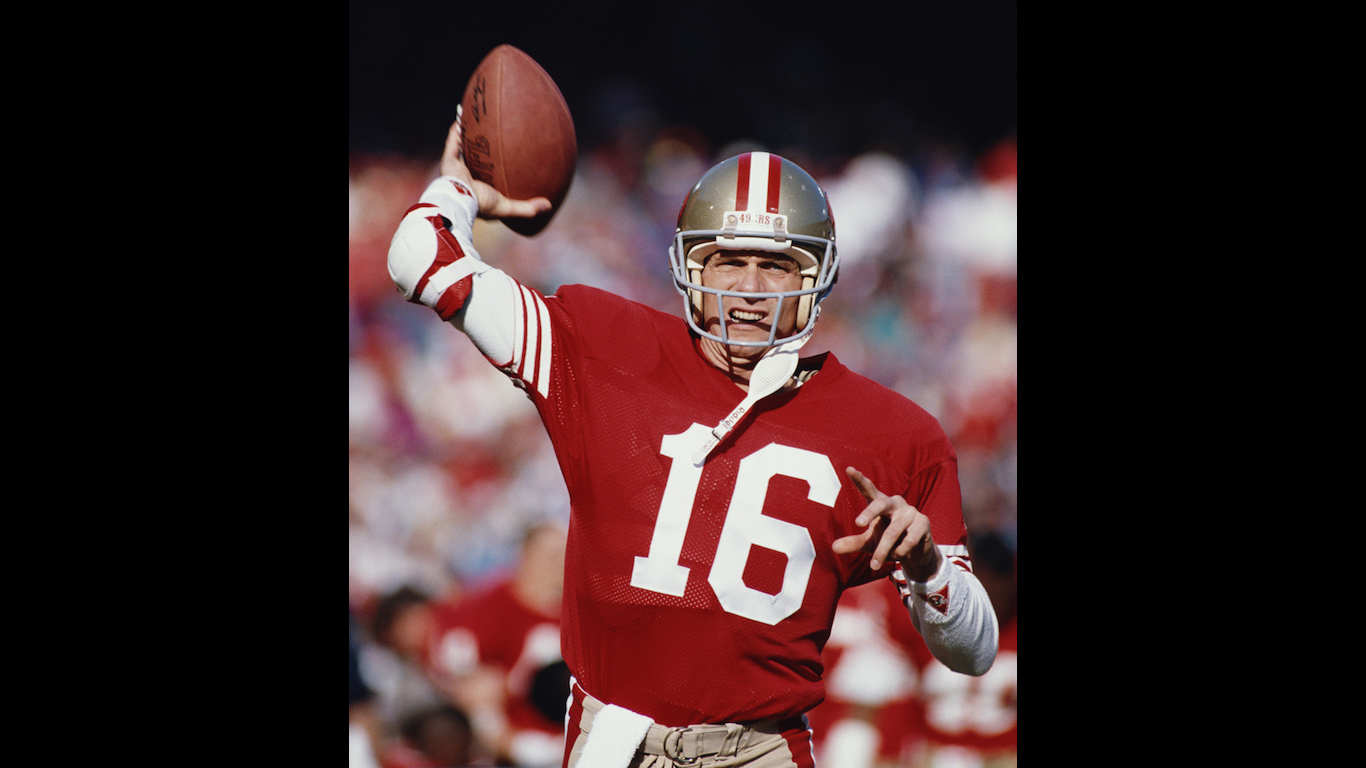
28. San Francisco 49ers: Joe Montana
> Years with 49ers: 1979-1992
> Stats with 49ers: 35,124 pass yds./244 TDs
> Record with team: 100-39
> Achievements with team: 7x Pro-Bowl, 3x All-Pro, 2x MVP, 4x Super Bowl champion, Hall of Fame
> Runner up: Steve Young
The last of the quarterbacks on our list to hail from the so-called cradle of quarterbacks of western Pennsylvania, and he is the best of them all. Joe Montana, also known as “Joe Cool” for his calmness under pressure, was destined for pro greatness. By the time he had entered the league in 1979, Montana had already won a national championship at Notre Dame.
Montana took charge of coach Bill Walsh’s West Coast offense and turned the 49ers into one of the greatest dynasties in NFL history.
At the start of the 49ers’ run, Montana authored one of the great endings in NFL history when he passed to Dwight Clark in the end zone to defeat the Dallas Cowboys in the NFC Championship Game in 1982 (a game attended by 4-year-old Tom Brady). San Francisco would go on to win the first of its four Super Bowls under Montana.
Montana cemented his image as the game’s greatest clutch performer in the ensuing years, a career that benefited from the talent of all-time great wide receiver Jerry Rice. Montana was the league MVP twice and received the Super Bowl MVP trophy three times.
On nearly every other franchise, Steve Young would be the greatest quarterback ever. Young was the MVP of Super Bowl XXIX, when he threw for six touchdowns. But Montana is still the team king in wins with 100, pass completions (2,929), passing yardage (35,124), and touchdown passes (244).

29. Seattle Seahawks: Russell Wilson
> Years with Seahawks: 2012-present
> Stats with Seahawks: 22,176 pass yds./161 TDs
> Record with team: 65-30-1
> Achievements with team: 4x Pro-Bowl, Super Bowl champion
> Runner up:tt Hasselbeck
Russell Wilson entered the NFL in 2012 with the knock that he was too short to win in the league. Wilson continues to prove the naysayers wrong.
In his 2012 rookie year, he tied Peyton Manning’s record for most passing touchdowns by a rookie (26). Wilson followed up that success by leading the Seahawks to two Super Bowls, winning one in 2014 — the second African-American quarterback to win a Super Bowl. In that game he threw for 206 yards, two touchdowns, and no interceptions for a 123.1 passer rating.
The following season, WIlson demonstrated his resilience in the NFC Championship Game. Trailing the Green Bay Packers 19-7 with five minutes left in the fourth quarter, Wilson rallied the Seahawks for two touchdowns that included a two-point conversion to take a temporary 22-19 lead. The Packers tied the game, but the Seahawks eventually won in overtime and gained their second straight Super Bowl trip.
Wilson is already third on the all-time passing leader list for the Seahawks in wins (65), completions (1,815), passing yards (22,176), and touchdown passes (161).
[in-text-ad-2]
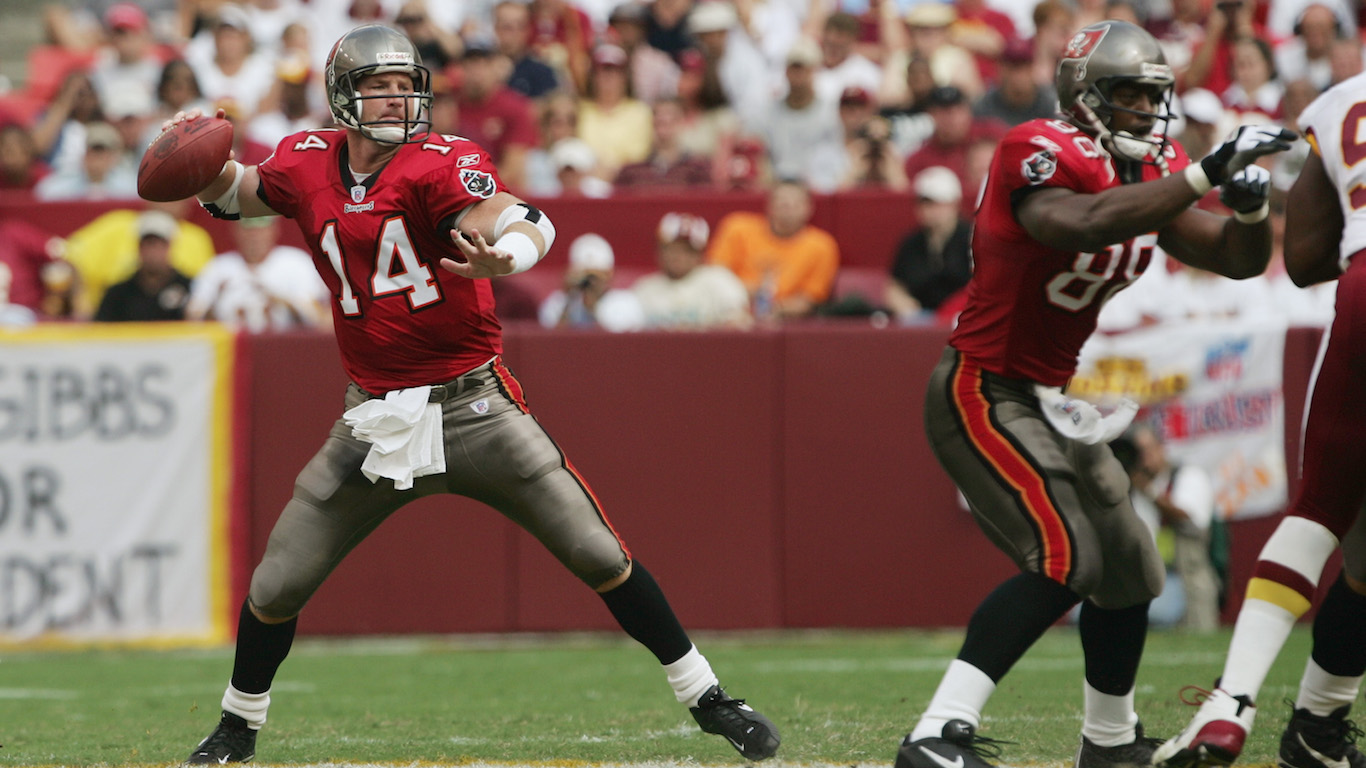
30. Tampa Bay Buccaneers: Brad Johnson
> Years with Buccaneers: 2001-2004
> Stats with Buccaneers: 10,940 pass yds./64 TDs
> Record with team: 26-23
> Achievements with team: Pro-Bowl, Super Bowl champion
> Runner up: Jameis Winston
Before leading the Buccaneers to their only Super Bowl victory, Brad Johnson was a journeyman quarterback known as the first quarterback to complete a touchdown pass to himself.
After stints at Minnesota and Washington, Johnson joined the Bucs in 2001 and set the team passing yardage record that year with 3,406 yards. He helped guide the Buccaneers to their only Super Bowl win in 2003. During that season, Johnson tossed 22 touchdown passes and was chosen for the Pro Bowl.
Jameis Winston, who joined Tampa Bay in 2015, will probably become the Bucs’ greatest quarterback. He has already surpassed Johnson in touchdown passes with 69 and in passing yardage with 11,636. But Johnson has a Super Bowl ring, and that makes him the greatest Bucs quarterback.

31. Tennessee Titans: Warren Moon
> Years with Titans: 1984-1993
> Stats with Titans: 33,685 pass yds./196 TDs
> Record with team: 70-69
> Achievements with team: 6x Pro-Bowl, Hall of Fame
> Runner up: Steve McNair
The Tennessee Titans were once known as the Houston Oilers, and when they were the Oilers, Warren Moon was their quarterback. He was a free-wheeling thrower who gained Hall of Fame recognition as a quarterback who could fling the ball.
Letting it fly is what got Moon a quarterback gig in the Canadian Football League for the Edmonton Eskimos, where he recorded 144 touchdown passes in six seasons. He moved on to Houston in 1984 and continued to go deep.
His best season in Houston was in 1990, when he threw for 33 scores against 13 interceptions and led the league with 4,689 yards and 362 completions.
Wins were harder to come by, and Moon had an undistinguished postseason record. With the Oilers, he was only 3-6, with 15 touchdown passes and 12 interceptions. Yet his credentials were good enough to get him enshrined in the Hall of Fame in 2006.
[in-text-ad]
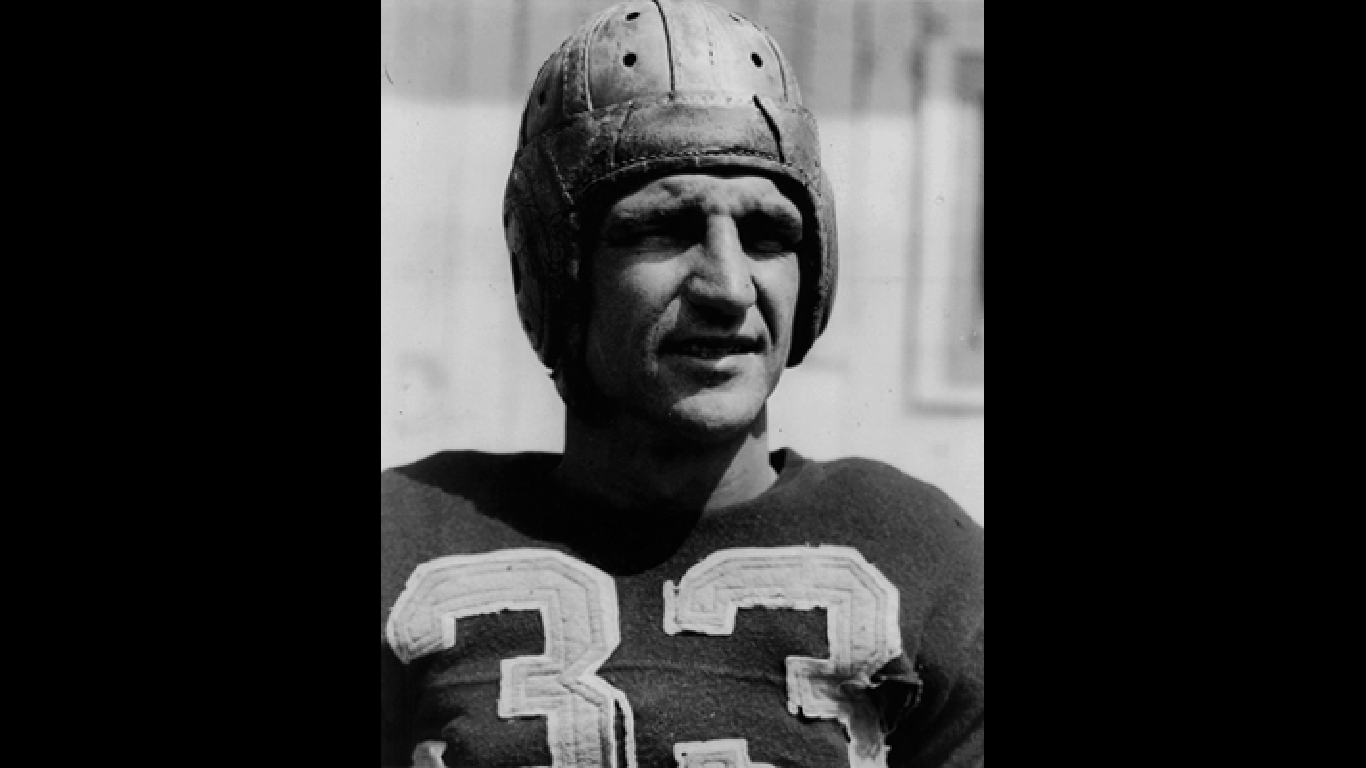
32. Washington Redskins: Sammy Baugh
> Years with Redskins: 1937-1952
> Stats with Redskins: 21,886 pass yds./187 TDs
> Record with team: 77-47
> Achievements with team: 6x Pro-Bowl, 4x All-Pro, 2x NFL champion, Hall of Fame
> Runner up: Joe Theismann
Like his signal calling contemporary Sid Luckman, Sammy Baugh helped define the modern quarterback.
Before Baugh, football games were grind-out affairs, and passing was only done when a team was forced to throw. Baugh helped change that. He led the NFL in passing yards four times, passing yards-per-game six times, completion percentage nine times, passing touchdowns twice, and passer rating four times.
Baugh led the Washington Redskins to NFL Championships in 1937 and 1942. In the 1937 title game, the Washington rookie threw three touchdown passes in the 28-21 victory over the Chicago Bears.
In 1994, the NFL named Baugh as one of four quarterbacks on its 75th-anniversary team, along with Otto Graham, Johnny Unitas, and Joe Montana. He was also among 17 inductees in the Pro Football Hall of Fame’s inaugural class of 1963.
Many NFL historians consider Baugh as the greatest player in NFL history for his versatility. But his nickname is Slingin’ Sammy for a reason, and he gets the nod over such Washington Redskins notables as Joe Theismann and Sonny Jurgensen.
Detailed Findings & Methodology
Seven of the quarterbacks listed are currently playing, burnishing their credentials for possible induction into the Hall of Fame, where 33 signal callers have achieved immortality.
Though quarterbacks come from all over the country, many hail from western Pennsylvania, sometimes called the “cradle of quarterbacks,” as well as from Texas and Ohio.
The 24/7 Wall St. list includes play-callers from every decade dating back to the 1930s. Though data is a key determinant in who made the list, certain quarterbacks such as Joe Namath gain inclusion because of the historical role they played in the spectacular growth of professional football.
Namath embraced the bright lights and glitz of New York City when he played for the Jets, ushering a new era in professional sports. Yet quarterback was not always the glamour position in football it is today. That distinction was reserved for running backs such as Jim Thorpe, Red Grange, and the famed “Four Horsemen” of Notre Dame. All of these ball carriers achieved gridiron glory by the 1920s.
In those days, football had rules that limited the effectiveness of the quarterback position, in particular the passing attack. But beginning in the 1930s, those restrictions were eased. The rule requiring a quarterback to be five yards behind the line of scrimmage to pass was abolished. Hash marks were placed on the field and established a specific zone where the ball could be placed between snaps. This allowed for greater offensive formation flexibility. Also, teams weren’t penalized for incomplete passes in the end zone that were counted as touchbacks or as turnovers.
Just as significant in the evolution of the quarterback position was the shift to the T-formation by many teams in the 1930s. The T-formation allowed for more offensive versatility and passing opportunities.
In more recent years, the NFL, knowing how important the quarterback is to the team, has tried to protect him with rules restricting contact by onrushing defenders during pass plays. Also, the league has limited how much contact pass defenders can have with receivers during passing routes. The rule modifications have helped increase quarterback’s passing efficiency and boosted statistics and also made for a more interesting and free-flowing game.
All of these rules changes underscore the importance of the quarterback for the team he plays for and why he is, in most cases, the highest-paid player on the team.
In order to determine each franchise’s best quarterback of all time, 24/7 Wall St. considered a player’s statistics (passing yards and touchdowns), honors (Pro Bowls, All-Pro awards, MVPs and Hall of Fame status), post season success (NFL or Super Bowl championships), and longevity with that franchise.
Players’ statistics and honors only include those accumulated while playing for the team listed. So even though Peyton Manning won two Super Bowls and five MVP awards, he’s listed as having won one Super Bowl and four MVPs. One championship and MVP award came during Manning’s time in Denver, not with the Indianapolis Colts.
The thought of burdening your family with a financial disaster is most Americans’ nightmare. However, recent studies show that over 100 million Americans still don’t have proper life insurance in the event they pass away.
Life insurance can bring peace of mind – ensuring your loved ones are safeguarded against unforeseen expenses and debts. With premiums often lower than expected and a variety of plans tailored to different life stages and health conditions, securing a policy is more accessible than ever.
A quick, no-obligation quote can provide valuable insight into what’s available and what might best suit your family’s needs. Life insurance is a simple step you can take today to help secure peace of mind for your loved ones tomorrow.
Click here to learn how to get a quote in just a few minutes.
Thank you for reading! Have some feedback for us?
Contact the 24/7 Wall St. editorial team.